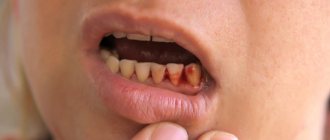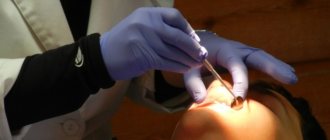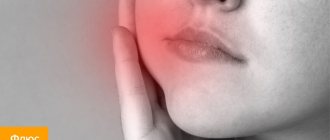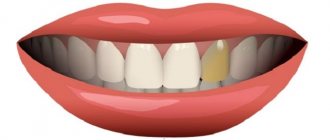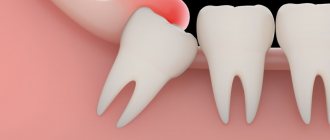The process of dental implantation is associated with a surgical intervention in the human body, during which an implant (a titanium pin simulating a tooth root) is installed in the jawbone, and then a crown is fixed to it.
Although implantation is not new as an effective and safe way to restore lost teeth using artificial roots, some people still consider it a painful procedure and prefer classic prosthetic solutions. Is dental implantation really painful? Let's try to understand this issue.
Dental pin: what is it, its advantages and disadvantages
What is a dental post? This is a specialized dental structure that looks like a rod. It is installed into the tooth root as a support for a filling or crown. Installation of a pin is only possible if the tooth has a healthy root. As a rule, this design is used if the tooth is badly damaged and thin walls remain.
Advantages:
- reducing the load on the tooth root;
- the ability to restore the crown in just one visit to the dentist;
- ease of installation;
- high level of aesthetics of the future artificial tooth;
- relatively low cost.
Flaws:
- instability under heavy chewing loads;
- there is a risk of damage to the root walls;
- allergic reactions and the development of secondary caries are possible;
- metal rods can only be removed together with the tooth.
To successfully install the pin, the following conditions will need to be met:
- the length of the rod must be at least 2/3 of the length of the dental canal;
- the size of the rim of healthy tooth tissue is at least 2 mm;
- root canal treatment was carried out with high quality;
- the root canal was given a cylindrical or conical shape.
How to install the pin? Does it hurt?
If you have entrusted dental treatment or prosthetics to a doctor from a clinic with a good reputation, there is no need to worry. We are sure that you will not experience any unpleasant sensations. First, the doctor will examine the tooth, decide on the use of a pin, and tell you how the installation will proceed.
If the root canal is filled, it will need to be unfilled to place the pin. This is followed by direct installation and fastening of the pin with a composite material.
Once the material has hardened and the pin is securely fastened, the doctor can begin restoring the shape of the tooth. If a pin is used on a front tooth, you should pay special attention to the restoration so that the shades of the restored tooth and the “neighbors” located next to it match, and the artificial tooth does not stand out from the series due to color.
How long does it take to install a pin and how painful is this process?
The duration of the procedure directly depends on the initial condition of the oral cavity. If there are no problems, the pin is placed in one visit to the dentist. If periodontal diseases and other pathologies are present, a pin will be installed in the tooth root only after they have been eliminated.
Since the doctor touches soft tissue during the implantation of the supporting element, the procedure is often accompanied by painful sensations. The occurrence of pain after nerve removal is a natural process. But if a long-depulped tooth hurts, it is possible that the rod has entered too deeply into the canal. X-rays will help identify the cause of the pain.
Indications and contraindications for installing pins
Indications:
- damage to the tooth crown by more than 50%;
- the need to create support for prostheses;
- tooth loss;
- weakening of the tooth due to dental diseases.
Contraindications:
- untreated caries;
- the presence of inflammatory processes in the area of the tooth root;
- root destruction;
- blood diseases;
- insufficient thickness of the root canal;
- the presence of caries and periodontal inflammation;
- granulomas, cysts;
- exacerbation of systemic diseases;
- pregnancy;
- allergy.
It is important to know. The choice of the most suitable type of pin is always up to the doctor. It is unacceptable to focus only on the cost of the dental structure.
Pin Installation Procedure
How to install a pin in a tooth? The procedure occurs in several stages:
- Removal of all dental tissues affected by caries.
- Preparing the bed for the pin using a special reamer and calibration cutter.
- Root canal preparation.
- Fitting the rod to the tooth.
- Installation of the pin; dual-curing adhesive is used as a fixing element.
- Restoration work using a crown or prepared filling material.
The Saint-Dent Clinic in Moscow offers a wide range of dental services for adults and children. The current cost of services can be found here, the contact page is located here.
Advantages and disadvantages
Positive aspects of the installation:
- a decaying tooth retains its shape;
- in the future, you can build up the tooth stump to install ceramic crowns;
- it becomes possible to restore the enamel;
- This way you can prevent tooth extraction;
- The pins are durable and should be replaced no earlier than every ten years.
There are many advantages to high-quality installation of pins
The disadvantages of this design include the following:
- the pin can become one of the causes of tooth decay;
- if the rod is installed incorrectly, it can cause caries;
- metal pins are susceptible to corrosion from external factors;
- allergies and pin rejection may occur;
- over time, the walls of the tooth become thinner, which leads to the subsequent removal of damaged teeth;
- installing a pin is a fairly expensive procedure, especially when using modern materials.
Unfortunately, there are also negative aspects to such a procedure.
Possible complications
- severe pain, swelling;
- root fracture;
- restoration chips;
- the occurrence of a local allergic reaction to the material from which the rod is made;
- development of the inflammatory process (stomatitis, periodontitis);
- cyst development;
- fistula formation;
- mechanical damage to the walls of the tooth, which can lead to perforation of the root canals;
- splinters from dental instruments getting into the root canal.
It is important to know. The most dangerous complication is rejection of the installed supporting element by the body. In this case, it must be completely removed from the oral cavity.
Why does pain occur after installation?
The causes of pain with a pin installed cannot be identified on your own. If you notice that after implantation the tooth area begins to hurt, be sure to make an appointment with a doctor.
Pain occurs due to unprofessional or erroneous actions of the dentist.
- The pin is set too deep. The pain is felt during physical impact (for example, chewing) and has an aching character.
- During installation, the dental canal was cleaned with errors, and the walls of the tooth were damaged.
- The filling material has not completely filled the root canal. It could also simply extend beyond the apical foramen.
- When a fragment or several fragments are found in the canal belonging to endodontic instruments.
- In case of poorly performed disinfection of the canal during the procedure.
There are many reasons why pain occurs after insertion of a pin.
Important ! When installing the pin, the doctor requires high concentration.
During cleaning, it is necessary to use all the necessary instruments and identify the position of the apical foramen. To monitor the condition, an additional x-ray is prescribed.
In addition to incorrectly performed medical procedures, there may be other causes of painful sensations.
Normally, aching pain in a tooth can last up to several days; over time it subsides and disappears completely. Sometimes the pain is associated with an allergy, when the body does not accept the material from which the pin is made. In such cases, x-rays usually show the real picture.
Some discomfort after the procedure is normal.
If pain is not observed immediately after the intervention, but after a long period, for example, after several years, then the reasons that led to its occurrence may be as follows.
- Failure to maintain proper oral hygiene.
- Minor damage to tooth tissue (usually occurs due to biting nuts and other hard objects, opening lids with teeth, etc.).
- Periodontal inflammation.
- The appearance of cysts on the roots of teeth.
- Serious tissue damage.
Video - Dentist about pain in a tooth without a nerve
- How long does it take for drugs to leave the body?
What to do if a tooth with a pin hurts
In the first hours, rinsing the mouth with a soda solution (1 teaspoon of soda per glass of water) will help relieve toothache. A decoction of chamomile and sage has a similar effect. You can also take painkillers and apply ice to your cheek in the area where the pin was placed.
It is important to know. The occurrence of slight swelling and pain in the first days after installation of the pin is normal. But if these symptoms persist for a long time and the patient experiences an elevated body temperature, you should consult a dentist.
Are there any contraindications for pin prosthetics technology?
Yes, like any serious medical procedure, this one also has a number of contraindications. First of all, they are related to the condition of the patient’s gums: periodontitis, as well as all kinds of granulomas and cysts.
Those who know about the presence of allergic reactions in their body should be especially careful when installing pins. Since the pin will be in contact with your tissues, it will be better if you are firmly confident that you are not allergic to its material.
The most common questions about pins and answers to them
Is it always possible to get by with a pin?
Unfortunately no. In case of significant tooth decay, when there is a risk of further destruction of the coronal part, dental prosthetics are recommended.
How to care for your teeth after having a pin installed?
For two weeks, it is not advisable to eat too hard food and use toothpicks. When brushing your teeth, you need to be as careful as possible so as not to injure your gums.
Is there an alternative to a dental post?
Yes, you can install a stump tab instead. This is a microprosthesis, the lower part of which is fixed into the root canals, and the upper part serves as a supporting element for an artificial crown.
Teeth extension techniques
There are several modern methods of teeth extension. The doctor will select the most suitable one after examining the patient. The choice will depend, first of all, on the degree of damage to the teeth.
Tooth extension with a filling
Photopolymer materials allow you to correct a small chip, crack in the enamel or a stain on it. They:
- match the natural color of the teeth,
- do not harm healthy dental tissues and oral mucosa,
- allow you to accurately recreate the damaged area,
- allow you to preserve the natural layer of enamel and nerves.
The procedure is affordable and does not take much time: a filling made from a special quick-hardening composition is installed on the chipped tooth.
Veneers and Lumineers
The use of these thin ceramic onlays, which hide tooth imperfections, is an artistic restoration.
Veneers visually enlarge teeth. To install them, the patient will have to visit the dentist at least 2 times so that the doctor:
- Selected the type of lining.
- Under anesthesia, I ground off the enamel at the installation site.
- Installed veneers with dental cement.
Lumineers hide darkened enamel, chips and cracks, and mask large spaces between teeth. They are thinner and lighter than veneers, their installation does not require grinding down the enamel, and removal does not harm it.
Tooth extension with a crown
If the tooth is almost completely destroyed, previous restoration methods will be ineffective. In this case, the doctor installs a crown.
Extension on a pin
If the tooth is seriously damaged, it is built up onto a pin. Doctor:
- Refers the patient for an x-ray.
- A pin - a rod made of titanium or fiberglass - is implanted into the bone tissue of the tooth.
- Forms the visible, crown part of the tooth.
How much tooth extension costs will depend on the complexity of the case and the chosen technique.

